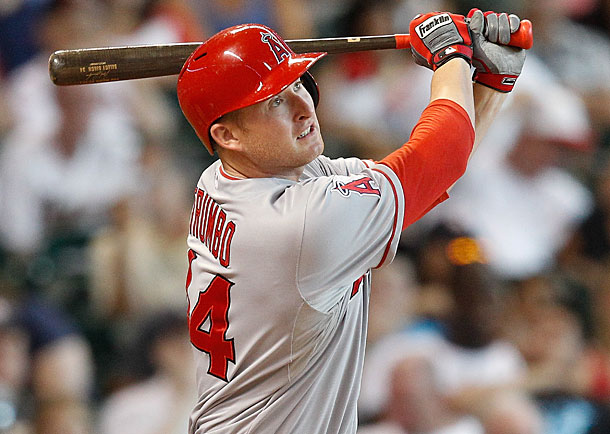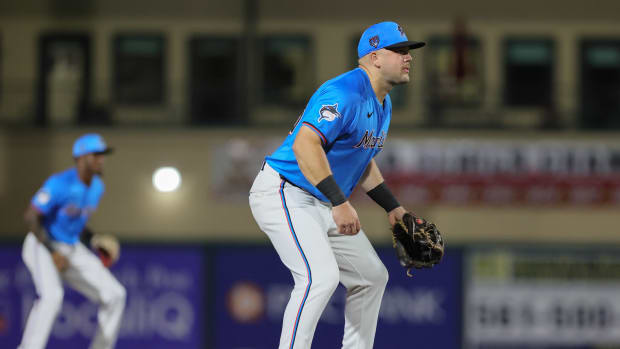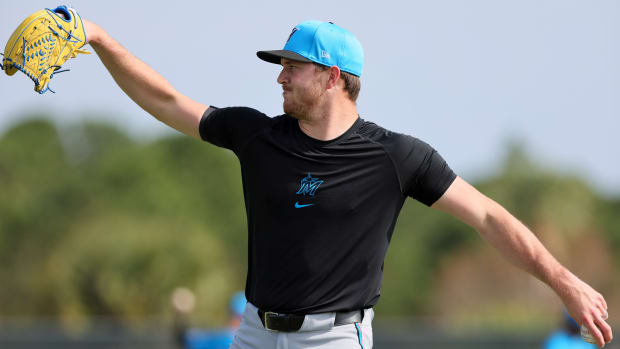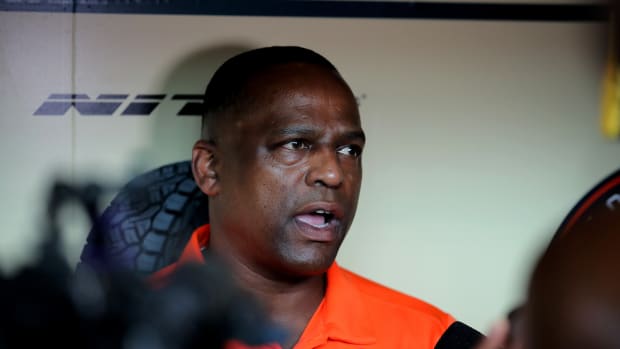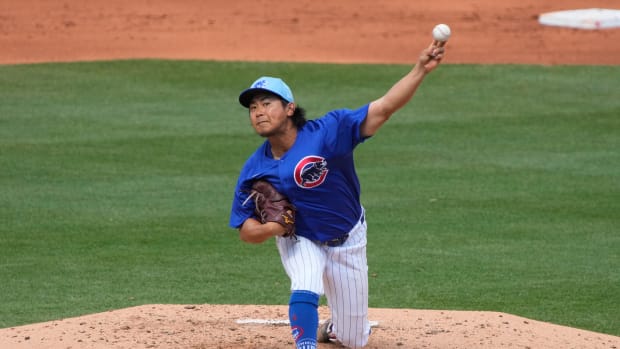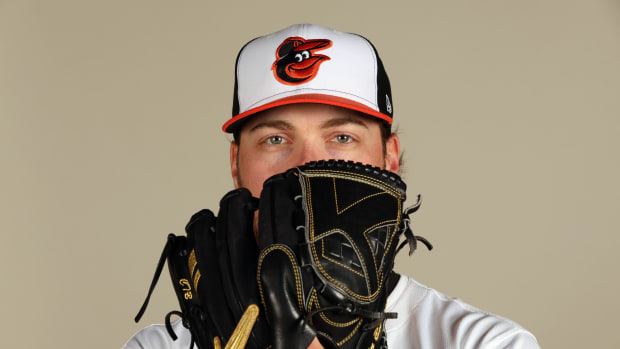Diamondbacks land Mark Trumbo in three-team deal
Mark Trumbo was an All-Star in 2012 and has averaged 32 home runs per year in his three full seasons. (Bob Levey/Getty Images)
In the first big move of the winter meetings, the Angels, Diamondbacks and White Sox completed a three-way trade that resulted in first baseman/outfielder Mark Trumbo going from Los Angeles to Arizona, pitcher Tyler Skaggs going in the opposite direction, reliever Hector Santiago going from Chicago to L.A. and outfielder Adam Eaton going from the D-backs to the White Sox. While Arizona received the powerful corner bat they sought in Trumbo, they surrendered a fair bit of club-controlled talent — two of their top three prospects heading into 2013 — to do so.
Trumbo, who turns 28 on Jan. 16 and is entering his first year of arbitration eligibility, is the most established player in the deal. He's also a 6-foot-4 slugger who has pounded 95 homers over the past three seasons, including a career-high 34 in 2013. For all of his power, his approach at the plate has its flaws, and his swing has some holes (check out this heat map from ESPN). Trumbo ranked fifth in the AL in total strikeouts (184) and seventh in strikeout rate (27.1 percent) in 2013, and while he also drew a career-high 48 unintentional walks, he hit just .234/.294/.453. Indeed, Trumbo's sketchy plate discipline and pull-tendency has led to a career .250/.299/.469 line and an average of 2.6 WAR per year in three-plus seasons with the Angels — useful but hardly star caliber.
Trumbo has a reputation as a mediocre defender, though he's been above average at first base during his career according to both Defensive Runs Saved (+12) and Ultimate Zone Rating (+17). With Paul Goldschmidt entrenched at first in Arizona, Trumbo is usually going to wind up in an outfield corner; he's been slightly above average in rightfield, but slightly below average in left. With the deal, the Diamondbacks will apparently start the season with Trumbo in left, A.J. Pollock in center and Gerardo Parra in right, with Cody Ross not likely to be ready to start the year following August surgery to repair a fracture in his right hip. Once he's ready, it's an open question as to what will happen, particularly given that Ross is owed $20 million over the next two seasons.
Eaton, who just turned 25, was supposed to be Arizona's centerfielder of the future. He came into the season ranked number 73 on Baseball America's Top 100 Prospects list (third in his organization) and was considered a possible candidate to win Rookie of the Year honors, but he sprained his left (throwing) ulnar collateral ligament during spring training and didn't join the Diamondbacks until July 9. In 66 games, he hit just .252/.314/.360 with three homers and five steals. His defense in centerfield was below average according to both DRS and UZR, albeit in a relatively small sample of games. By comparison, the less heralded Pollock — a 2009 first-round pick out of Notre Dame who hadn't dented prospect lists — hit .269/.322/.409 with eight homers and 12 steals as a 25-year-old rookie this past season.
Barring further moves in Chicago, Eaton will be flanked by some combination of 23-year-old Avasail Garcia, 25-year-old Dayan Viciedo and 30-year-old Alejandro de Aza, giving the White Sox an inexpensive and relatively young outfield that doesn’t appear to have a ton of power. General manager Rick Hahn was particularly keen on the lefty-swinging Eaton as a player who could bat at the top of the lineup, helping to give them more of a lefthanded presence and improve an offense whose .302 OBP ranked second-to-last in the league.
On top of last month's trade of Peter Bourjos to St. Louis, the Angels' trade of Trumbo leaves them with an outfield of Josh Hamilton in left, Mike Trout in center and Kole Calhoun in right, with their DH spot now vacant. They made the move in order to upgrade their starting pitching, which ranked sixth in the league in quality start rate (54 percent) but 11th in ERA (4.30) and strikeout rate (6.9 per nine). Jered Weaver and C.J. Wilson are a solid 1-2 punch, and Garrett Richards has earned a spot in the rotation, but with Jason Vargas gone to the Royals via free agency, and both Jerome Williams and the disappointing Tommy Hanson nontendered, the only experienced starter left on the roster is Joe Blanton, who was rocked for a 6.04 ERA in 2013, his first year of a two-year, $15 million deal.
Santiago and Skaggs should both do better than that. Both could start the year in the rotation, depending upon what else the Angels do before Opening Day; they could still sign a free agent starter such as Matt Garza. Both lefties will likely benefit from moves to more pitcher-friendly parks. Santiago, who turns 26 on Dec. 16, is a lefty who put up a 3.56 ERA in 149 innings split between 23 starts and 11 relief appearances — all of the latter before mid-June — for the White Sox. While just 52 percent of his starts were quality, his ERA and peripherals were all somewhat better in that capacity than in relief, though he had success out of the bullpen in 2012; overall, he finished at 8.3 strikeouts, 4.3 walks and 1.0 homers per nine. Via Baseball Prospectus, that combination only comes out to a 4.47 FIP; he held opposing hitters to a .193/.313/.222 line in 165 PA with runners in scoring position, something that's likely to regress. He relies mainly upon a low-to-mid-90s fastball, with a changeup and screwball in the mix.
As for Skaggs, the 22-year-old lefty is returning to the organization that made him a supplemental first-round pick in 2009, then sent him to Arizona as the player to be named later in the Dan Haren deal in August 2010. He's cracked Baseball America's Top 100 Prospects list in each year since then, climbing from 83 in 2011 to 13 in 2012 to 12 in 2013. At 6-foot-5 and 215 pounds, he's skinny and long-levered, with a 90s-ish fastball, a swing-and-miss curve and an average or better changeup, but he struggles to repeat his delivery, causing command troubles that have led him to be roughed up at the big league level. In 13 starts over the past two seasons, he's yielded a 5.43 ERA, striking out 7.5 per nine but with inflated walk and homer rates (3.5 and 1.7 per nine, respectively). Though he struck out more than a batter per inning at Triple A Reno, he was touched for a 4.59 ERA there as well.
Those struggles and the development of Patrick Corbin (also part of the Haren deal) and top prospect Archie Bradley have led the Diamondbacks to view Skaggs less as a front-of-the-rotation type than a mid-rotation piece, and thus expendable. Barring further deals, Arizona will head into the year with a starting five of Corbin, Brandon McCarthy, Wade Miley, Trevor Cahill and Randall Delgado, with Bradley, who finished the year in Double A, possibly pushing his way to Arizona by midseason.






























